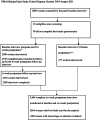Magnitude and determinants of early initiation and exclusive breastfeeding at six weeks postpartum: evidence from the PMA Ethiopia longitudinal survey
- PMID: 38178243
- PMCID: PMC10765766
- DOI: 10.1186/s13006-023-00611-y
Magnitude and determinants of early initiation and exclusive breastfeeding at six weeks postpartum: evidence from the PMA Ethiopia longitudinal survey
Abstract
Background: Early initiation and exclusive breastfeeding are crucial in preventing child morbidity and mortality. Despite the importance of these practices, rates of timely initiation of breastfeeding and exclusive breastfeeding remain suboptimal in many sub-Saharan countries, including Ethiopia. This paper aimed to estimate the prevalence and identify determinants of breastfeeding initiation within the first hour after birth and exclusive breastfeeding in Ethiopia.
Methods: Data from the Performance Monitoring for Action Ethiopia project, a national survey conducted from August 2019 to September 2020, were used. The analytical sample comprises 2564 postpartum women and their children; data reported at baseline during enrollment and six weeks postpartum were used in this analysis. A multi-level binary logistic regression model was employed to identify determinant factors linked with initiation breastfeeding and exclusive breastfeeding.
Results: Of the 2564 mothers, 77.8% of infants breastfed within the first hour of birth and 68.4% of women practiced exclusive breastfeeding at six weeks postpartum with significant variation across regions. In the multivariate analysis, mothers who had cesarean delivery were less likely to initiate early breastfeeding as compared to mothers with vaginal delivery (AOR 0.27; 95% CI 0.17, 0.41). The odds of early initiation of breastfeeding were higher for mothers whose baby cried immediately after birth (AOR 3.31; 95% CI 1.95, 5.62) and who had skilled assisted delivery (AOR 2.13; 95% CI 1.01, 4.48). Other factors that were significantly associated with early initiation of breastfeeding were obstetric complication(s), parity, immediate mother-to-baby skin-to-skin contact, immediate postnatal care and the region. Similarly, mothers whose babies had a good neonatal birth status (AOR 1.81; 95% CI 1.09, 2.99) were more likely to exclusively breastfeed their child at six weeks postpartum.
Conclusions: Early initiation of breastfeeding and exclusive breastfeeding is sub-optimal in Ethiopia. Nutrition programmers should consider regional variations in designing intervention programs to enhance breastfeeding practices. Healthcare providers should give special attention to women at risk such as those giving birth through cesarean section and having obstetric complications during delivery.
Keywords: Ethiopia; Exclusive breastfeeding; Factors; Longitudinal data; Prevalence; Timely initiation breastfeeding.
© 2023. The Author(s).
Conflict of interest statement
The authors declare no competing interests.
Figures




References
-
- Devine S, Taylor G, UNICEF. Every child alive: The urgent need to end newborn deaths: Unicef; 2018.
-
- World Health Organization. Indicators for assessing infant and young child feeding practices: definitions and measurement methods. 2021.
Publication types
MeSH terms
LinkOut - more resources
Full Text Sources
Medical

